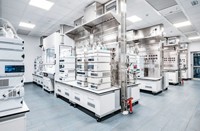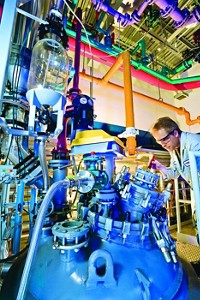Advertisement
Grab your lab coat. Let's get started
Welcome!
Welcome!
Create an account below to get 6 C&EN articles per month, receive newsletters and more - all free.
It seems this is your first time logging in online. Please enter the following information to continue.
As an ACS member you automatically get access to this site. All we need is few more details to create your reading experience.
Not you? Sign in with a different account.
Not you? Sign in with a different account.
ERROR 1
ERROR 1
ERROR 2
ERROR 2
ERROR 2
ERROR 2
ERROR 2
Password and Confirm password must match.
If you have an ACS member number, please enter it here so we can link this account to your membership. (optional)
ERROR 2
ACS values your privacy. By submitting your information, you are gaining access to C&EN and subscribing to our weekly newsletter. We use the information you provide to make your reading experience better, and we will never sell your data to third party members.
Pharmaceuticals
Nanosyn Acts Fast
Within months, the contract research firm entered a manufacturing joint venture and bought a plant
by Rick Mullin
December 7, 2009
| A version of this story appeared in
Volume 87, Issue 49

This summer, Nanosyn, a San Francisco-area drug contract research firm, was looking to start producing active pharmaceutical ingredients (APIs) in larger quantities. Across the Atlantic, Paris-based contract manufacturer PCAS was on the lookout for a U.S. or Canadian partner in order to launch North American production. Meanwhile, the owners of Seres Laboratories, a faltering contract manufacturer that is a two-hour drive from Nanosyn, were looking to get out of the business.
The three parties found each other, and things fell into place in a matter of months. Nanosyn formed a contract manufacturing venture with PCAS called PCAS-Nanosyn and purchased the assets of Seres. By most accounts, everyone involved was lucky to find each other. But for Nikolai Sepetov, chief executive officer of Nanosyn, the company at the center of the deal-making, luck doesn’t just happen. “Luck,” Sepetov says, “is coming to prepared people.”
Discussing Nanosyn at its Menlo Park, Calif., headquarters, Sepetov and Olga Issakova, executive vice president, describe a methodical approach to building a contract research firm geared to small-scale discovery chemistry. It’s an approach that they say prepared them to rapidly land a joint venture with a European API producer and acquire Seres’ facility.
The story begins in 1992, when both chemists emigrated from the Soviet Union to work for Selectide, a combinatorial chemistry pioneer based in Tucson, Ariz. The idea for Nanosyn emerged after Selectide was acquired by Marion Merrell Dow, which in turn was purchased by Hoechst. Sepetov watched the entrepreneurial company he worked for become the combinatorial chemistry arm of a big drugmaker. “We were not extremely happy,” he says, “coming from the Soviet Union, where there is a lot of bureaucracy, to a big company with a lot of bureaucracy.”
Sepetov and Issakova decided to start a small discovery chemistry firm that would possess the speed and efficiency required by pharmaceutical innovators, which in most cases were emerging biotech firms. “I found an angel investor, and we started Nanosyn,” Sepetov says.
Initially called Nanoscale Combinatorial Synthesis, the company launched in Tucson in 1998 and began adding technology—liquid chromatography/mass spectrometry, microfluidics, nuclear magnetic resonance, and microwave technology—much of it via secondhand machines. It got to work with customers, including the lab equipment firm Caliper Life Sciences.
Nanosyn managed to pay off its initial investors quickly and has been self-sustaining ever since. “Some call it an old-fashioned way of doing business—not getting huge credit,” Issakova says. “Our approach was to live on the money we earned.”
It turned out that an advantage to working with small firms was avoiding the trend among large drug companies toward outsourcing to India and China. While big pharma pursued low-cost research and production, Nanosyn tried to focus on higher value research collaborations. “What differentiates us from India and China is that we participate in creating intellectual property,” Sepetov says.
Nanosyn managed to expand by 40% annually, according to Sepetov, and now has annual sales of more than $10 million and about 70 employees. The company opened laboratories in North Carolina and San Diego, in both cases responding to customer requests that the firm work nearby.
The North Carolina site illustrates an opportunistic bent that foreshadowed the Seres deal. Caliper had formed a chemogenomics firm, Amphora, that was interested in Nanosyn’s microchemistry expertise. “It got over $100 million in investment in 2003,” Sepetov says. “Money was flowing back then. But Amphora finally failed when the investor pulled out. We acquired the facility for not much money.”
More recently, Sepetov says, Nanosyn’s customers have been seeking small-scale synthesis of clinical compounds made to the Food & Drug Administration’s current Good Manufacturing Practice (cGMP) standards. Seeking to respond, Nanosyn started looking last year for a partner that knew how to deal with FDA and other regulatory agencies.
Sepetov and Issakova met PCAS executives at the annual Pharma ChemOutsourcing meeting in Long Branch, N.J., last year. “The situation is very simple,” Sepetov says. “Nanosyn has worked with biotechs for 11 years. PCAS has been doing cGMP production for a decade, and they know all the regulations and how to do things right. We started looking for space.”
After ruling out building capacity at its Menlo Park site, Nanosyn began scouring the San Francisco area for assets. “I got a call from a venture capital firm suggesting I look at this company in Santa Rosa,” Sepetov says. “I met with the president, and in two days, we were in negotiations.”
Nanosyn purchased Seres’ assets, including six cGMP kiloscale labs and an R&D facility, and set about establishing joint operations with PCAS. “We are adding a lot of instrumentation and doubling the number of hoods in the laboratory,” Sepetov says. Nanosyn plans to augment manufacturing as well. The project started in the summer and is due to be completed early this month.
“It is important to note we are building a new company—a totally different company from Seres,” Issakova says. Sepetov adds that it is also important to note that PCAS-Nanosyn is a 50-50 joint venture. “PCAS did not acquire Nanosyn,” he says, admitting he is sensitive to misunderstandings about his company. It often gets lumped together with ChemBridge and ChemDiv, two contract research firms that are based in the U.S. but do much of their work in Russia.
James Bruno, president of consulting firm Chemical & Pharmaceutical Solutions, is familiar with Nanosyn, and he has an opinion of this summer’s deals. “Seres got the best deal,” he says. “They got out of the business very nicely. Nanosyn got the second best. They got decent assets.” Bruno notes that Nanosyn is gaining recognition for its strength in medicinal chemistry and analytical services.
“PCAS comes in third,” Bruno says. The French firm will have access to Nanosyn’s biotech customer base, “and, in principle, they get an office on the West Coast. On paper, it looks like a good deal for everybody,” he says.
Joseph Tessier, vice president of PCAS Americas, confirms that his bosses are indeed quite satisfied. “In my opinion, we are very lucky,” he says. “We already have had requests from European customers who want to have work done at the site. We are evaluating two projects.”
And PCAS likes Nanosyn’s aggressive attitude, Tessier says. Issakova shrugs in agreement. “We try to solve each problem, and we try to do it fast,” she says. “Clients heard we planned to have cGMP by 2009, and they said it’s just not possible. But if you are able to move fast and be really focused, anything is possible. This is kind of the philosophy of the company.”





Join the conversation
Contact the reporter
Submit a Letter to the Editor for publication
Engage with us on Twitter